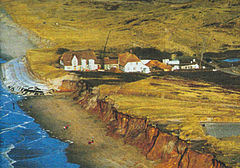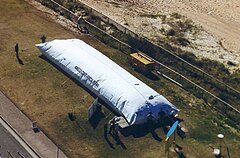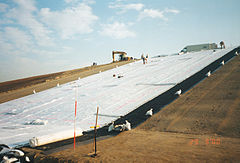
Geotechnical engineering, also known as geotechnics, is the branch of civil engineering concerned with the engineering behavior of earth materials. It uses the principles of soil mechanics and rock mechanics to solve its engineering problems. It also relies on knowledge of geology, hydrology, geophysics, and other related sciences.

A leachate is any liquid that, in the course of passing through matter, extracts soluble or suspended solids, or any other component of the material through which it has passed.

Geotextiles are versatile permeable fabrics that, when used in conjunction with soil, can effectively perform multiple functions, including separation, filtration, reinforcement, protection, and drainage. Typically crafted from polypropylene or polyester, geotextile fabrics are available in two primary forms: woven, which resembles traditional mail bag sacking, and nonwoven, which resembles felt.
Landscape products refers to a group of building industry products used by garden designers and landscape architects and exhibited at trade fairs devoted to these industries. It includes: walls, fences, paving, gardening tools, outdoor lighting, water features, fountains, garden furniture, garden ornaments, gazebos, garden buildings, pond liners.

Geocomposites are combinations of two or more geosynthetic materials for civil engineering applications that perform multiple geosynthetic functions, the five basic functions are: separation, reinforcement, filtration, drainage, and containment. Such composite materials may enhance technical properties of the soil or the geotechnical structure and minimize application costs.
A geomembrane is very low permeability synthetic membrane liner or barrier used with any geotechnical engineering related material so as to control fluid migration in a human-made project, structure, or system. Geomembranes are made from relatively thin continuous polymeric sheets, but they can also be made from the impregnation of geotextiles with asphalt, elastomer or polymer sprays, or as multilayered bitumen geocomposites. Continuous polymer sheet geomembranes are, by far, the most common.

A geogrid is geosynthetic material used to reinforce soils and similar materials. Soils pull apart under tension. Compared to soil, geogrids are strong in tension. This fact allows them to transfer forces to a larger area of soil than would otherwise be the case.
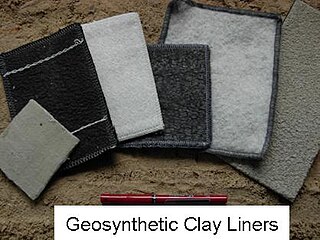
Geosynthetic clay liners (GCLs) are factory manufactured hydraulic barriers consisting of a layer of bentonite or other very low-permeability material supported by geotextiles and/or geomembranes, mechanically held together by needling, stitching, or chemical adhesives. Due to environmental laws, any seepage from landfills must be collected and properly disposed of, otherwise contamination of the surrounding ground water could cause major environmental and/or ecological problems. The lower the hydraulic conductivity the more effective the GCL will be at retaining seepage inside of the landfill. Bentonite composed predominantly (>70%) of montmorillonite or other expansive clays, are preferred and most commonly used in GCLs. A general GCL construction would consist of two layers of geosynthetics stitched together enclosing a layer of natural or processed sodium bentonite. Typically, woven and/or non-woven textile geosynthetics are used, however polyethylene or geomembrane layers or geogrid geotextiles materials have also been incorporated into the design or in place of a textile layer to increase strength. GCLs are produced by several large companies in North America, Europe, and Asia. The United States Environmental Protection Agency currently regulates landfill construction and design in the US through several legislations.

Mechanically stabilized earth is soil constructed with artificial reinforcing. It can be used for retaining walls, bridge abutments, seawalls, and dikes. Although the basic principles of MSE have been used throughout history, MSE was developed in its current form in the 1960s. The reinforcing elements used can vary but include steel and geosynthetics.
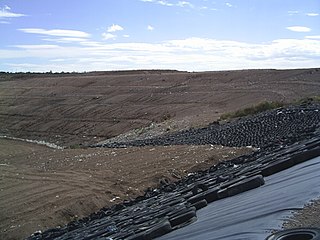
A landfill liner, or composite liner, is intended to be a low permeable barrier, which is laid down under engineered landfill sites. Until it deteriorates, the liner retards migration of leachate, and its toxic constituents, into underlying aquifers or nearby rivers from causing potentially irreversible contamination of the local waterway and its sediments.

Cellular confinement systems (CCS)—also known as geocells—are widely used in construction for erosion control, soil stabilization on flat ground and steep slopes, channel protection, and structural reinforcement for load support and earth retention. Typical cellular confinement systems are geosynthetics made with ultrasonically welded high-density polyethylene (HDPE) strips or novel polymeric alloy (NPA)—and expanded on-site to form a honeycomb-like structure—and filled with sand, soil, rock, gravel or concrete.
A geonet is a geosynthetic material similar in structure to a geogrid, consisting of integrally connected parallel sets of ribs overlying similar sets at various angles for in-plane drainage of liquids or gases. Geonets are often laminated with geotextiles on one or both surfaces and are then referred to as drainage geocomposites. They are competitive with other drainage geocomposites having different core configurations.
Final cover is a multilayered system of various materials which are primarily used to reduce the amount of storm water that will enter a landfill after closing. Proper final cover systems will also minimize the surface water on the liner system, resist erosion due to wind or runoff, control the migrations of landfill gases, and improve aesthetics.
Novel polymeric alloy (NPA) is a polymeric alloy composed of polyolefin and thermoplastic engineering polymer with enhanced engineering properties. NPA was developed for use in geosynthetics. One of the first commercial NPA applications was in the manufacturer of polymeric strips used to form Neoloy® cellular confinement systems (geocells).
Electrical liner integrity surveys, also known as leak location surveys are a post-installation quality control method of detecting leaks in geomembranes. Geomembranes are typically used for large-scale containment of liquid or solid waste. These electrical survey techniques are widely embraced as the state-of-the-art methods of locating leaks in installed geomembranes, which is imperative for the long-term protection of groundwater and the maintenance of water resources. Increasingly specified by environmental regulations, the methods are also applied voluntarily by many site owners as responsible environmental stewards and to minimize future liability.
Ronald Kerry Rowe, OC, BSc, BE, PhD, D.Eng, DSc (hc), FRS, FREng, NAE, FRSC, FCAE, Dist.M.ASCE, FEIC, FIE(Aust), FCSCE, PEng., CPEng. is a Canadian civil engineer of Australian birth, one of the pioneers of geosynthetics.

Jean-Pierre Giroud is a French geotechnical engineer and a pioneer of geosynthetics since 1970. In 1977, he coined the words "geotextile" and "geomembrane", thus initiating the "geo-terminology". He is also a past president of the International Geosynthetics Society, member of the US National Academies, and Chevalier de la Légion d'Honneur.
Jorge G. Zornberg is Professor and Joe J. King Chair in Engineering in the geotechnical engineering program at the University of Texas at Austin. He has over 35 years' experience in geotechnical and geoenvironmental engineering. He is also one of the pioneers of geosynthetics.
The Neoloy Geocell is a Cellular Confinement System (geocell) developed and manufactured by PRS Geo-Technologies Ltd. Geocells are extruded in ultrasonically welded strips. The folded strips are opened on-site to form a 3D honeycomb matrix, which is then filled with granular material. The 3D confinement system is used to stabilize soft subgrade soil and reinforce the subbase and base layers in flexible pavements. Cellular confinement is also used for soil protection and erosion control for slopes, including channels, retention walls, reservoirs and landfills.

The International Geosynthetics Society (IGS) is an engineering professional society focused on the field of geosynthetics, which are polymeric materials used in geotechnical engineering. The IGS describes itself as "a learned society dedicated to the scientific and engineering development of geotextiles, geomembranes, related products, and associated technologies." It was founded in Paris in 1983 as the International Geotextile Society and is a member of the Federation of International Geo-Engineering Societies, along with the International Society of Soil Mechanics and Geotechnical Engineering (ISSMGE), International Society for Rock Mechanics and Rock Engineering (ISRM), and International Association for Engineering Geology and the Environment (IAEG).
